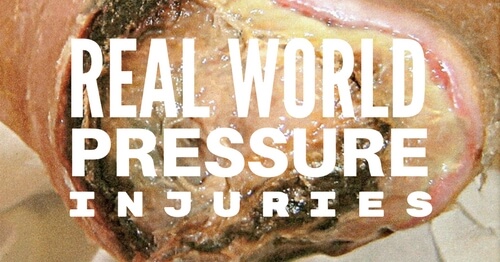This wound care Q&A answers five of the most common questions about pressure injury staging dilemmas (that you probably didn’t learn from textbooks).
In the world of wound care, just as in real life, the phrase, “Expect the unexpected” couldn’t be more appropriate. Clinicians can do everything exactly by the book, only to find that a wound just won’t heal, or the source of the problem appears to be one thing but then ends up being another. This is especially true with pressure injuries and often makes pressure injury staging a challenge.
Oh, sure, we have awesome resources, like the 2016 NPUAP Pressure Ulcer Staging Guidelines.
But in the real world, staging pressure injuries can be downright tricky. We see pressure injuries happening from pressure, pressure with shearing, and even caused by medical devices. In addition, pressure injuries may not develop in exactly the way would we expect, such as when a pressure injury heals only to open up again later.
That’s why we’re here to help – by addressing five of the most common pressure injury staging questions we get in the field..
Pressure Injury Staging Q&A
Question: Can a wound have two stages? My patient has a Stage 3 pressure injury, but I also see dark purple around part of it. Should I document it as Stage 3 with deep tissue injury (DTI)?
Answer: A wound cannot have two stages. Stage the entire pressure injury based upon the deepest level of tissue destruction. In this case, the wound would be considered Stage 3.
Q: If a wound first presents as an DTI and then becomes open, should I chart it as a healing DTI or restage it as it presents?
A: Staging is based on the deepest level of destruction through the layers of skin and tissue structures; therefore, you stage according to what level of destruction you see and/or feel. So, as the injury changes characteristics, you should restage it based upon what you see. Remember to refer back to the definitions for each stage. If you can’t tell what you are looking at, document the wound as unstageable for now and recheck later to see if you can put an accurate stage on it.
Q: What would be the new stage for a Stage 2 pressure injury that develops slough?
A: Again, staging is based on the deepest level of destruction through the layers of skin and tissue structures. You would stage the injury according to the level of destruction you see and/or feel. If you can no longer see or palpate the deepest level of tissue destruction in the wound, it has become unstageable.
Q: If a pressure injury heals but later reopens at the same site, how do I stage it?
A: According to the National Pressure Ulcer Advisory Panel (NPUAP), when a pressure injury reopens in the same site, the wound should be listed at the previous staging diagnosis. For example, if it was a Stage 3 before it closed, it would be a Stage 3 when it reopened. Pressure injuries heal to a progressively shallower depth. They don’t replace lost dermis, subcutaneous fat or muscle before they re-epithelialize. Instead, the full-thickness pressure injury is filled with scar tissue composed primarily of endothelial cells, fibroblasts, collagen, and extracellular matrix. A Stage 4 pressure injury, therefore, can never become a Stage 3 or lower stage pressure injury.
Q: Once a pressure injury is debrided, does it become a surgical wound and no longer need staging?
A: According to the Centers for Medicare & Medicaid Services (CMS), a pressure injury that has been surgically debrided remains a pressure injury, and isn’t considered a surgical wound.
What’s Your Staging Challenge?
Now that we’ve discussed five of the most common pressure injury staging challenges, we’d like to hear from you. What type of staging challenges have you experienced? Do you find it more difficult to assess pressure injury in certain kinds of situations or with specific patient populations? Please tell us about your experiences. And if you have additional questions about this topic you’d like answered, post them here. We may use them for future blogs!
What do you think?

